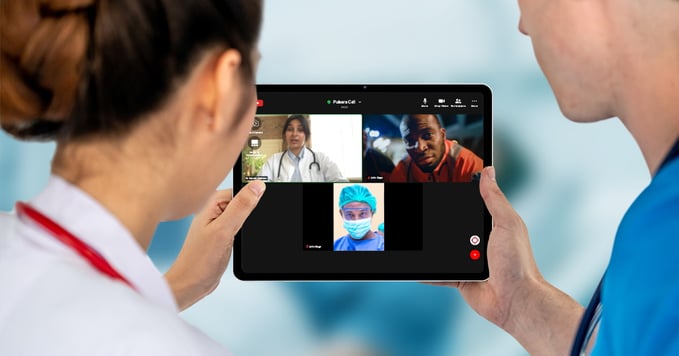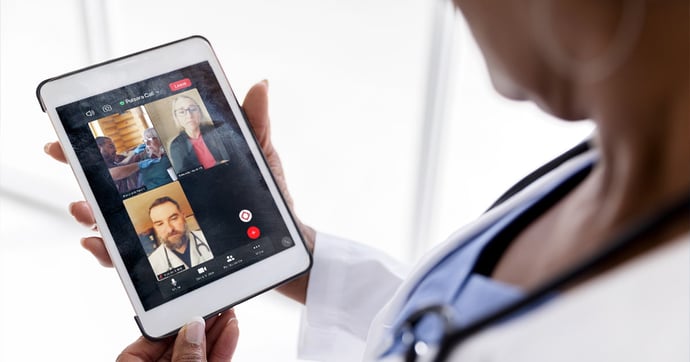Editor’s Note: This post was updated in January 2025 for accuracy and comprehensiveness.
—
Years after the global COVID-19 pandemic, hospitals worldwide are still struggling with the many challenges it created for healthcare organizations—chief among them, severe staffing shortages. Clinicians are facing longer hours, fewer resources, more responsibilities stretched between fewer people, lack of support or understanding from the general public, and ultimately higher rates of burnout.
As a result, hospitals are grappling with unsustainably low staff retention. According to the US Chamber of Commerce, regional nursing turnover rates range from 9% to as high as 37%, with 58% of nurses leaving the job within 2 years of starting.
While there will need to be an influx of over 60,000 new nurses by 2030 to satisfy staffing demand, not all strategies for coping with the shortage have to do with recruitment. Technology can help make complex and frustrating tasks more simple. And according to a 2022 study, that might just be the determining factor in whether or not nurses decide to stay in the profession.
By streamlining workflows, technology can save a great deal of time and energy for hospital staff, making cumbersome and stressful processes smooth and efficient. Here's how.

1. Technology can help simplify communication for hospital staff, cutting down on the time and effort it takes to relay information.
Many of the nurses involved in a 2022 Hospital IQ survey offered suggestions that would make them consider staying with their current hospital. Of those surveyed, 53% of nurses "want streamlined processes that ensure visibility into patient needs and communication." Better communication across departments was also a priority for 45%.
This is one issue technology can solve. The right communication solution can help care teams seamlessly communicate with one another, transmitting information instantly and eliminating many barriers and frustrations. Platforms like Pulsara allow care team members to upload information about their patients to a patient channel, which is viewable to everyone involved in the patient's care. Care team members can pull in whoever they need to alert, at their own organization or at others, and communicate instantly using key vitals information, instant messaging, photos, notes, audio clips, and even audio and live video.
Improvements to communication also tend to improve nurse satisfaction and have been shown to cut down on time-to-treatment across disciplines. With a system that is quick and easy to use, clinicians spend less time worrying about getting their message through and more time focusing on their patients.

2. Using technology to improve communication can help mitigate medical errors.
Another unfortunate side effect of insufficient staffing is an increase in medical errors. As nurses try their best to cope with severe shortages, attempts to push through exhaustion can result in mistakes they wouldn't normally make.
Improved communication around patient care has been shown to help reduce medical errors by providing clarity and transparency. Using technological tools to help facilitate faster, clearer communication between hospital care teams can help avoid preventable mistakes.
3. Telehealth can help connect patients with specialists with the touch of a button.
When the COVID-19 pandemic hit in 2020, clinicians needed a way to continue treating patients from a distance. This led to a loosening of restrictions and an explosion in telehealth capabilities, which has opened many doors in the years since.
The right telehealth solution isn't just for general practitioners looking to conduct scheduled appointments with patients. Now, telehealth can also help in emergent environments—from a clinician seeking a second opinion from a colleague to a care team consulting with a specialist at a facility across their state. Telehealth consults can be requested and performed instantly.

During the later stages of the pandemic, the State of Texas used Pulsara to enable flexible telehealth interactions, allowing patients without a primary care physician to receive an evaluation and approval to undergo monoclonal antibody therapy through a telehealth consult with a physician.
Leveraging telehealth can help remove roadblocks in treatment by bringing specialists to the patient, allowing them to be evaluated quickly and moved to the next stage of treatment without having to move the patient elsewhere. This can save a great deal of time, energy, resources, and frustration for everyone involved and helps the patient receive better care faster.
4. Technology can help coordinate and streamline patient transfers, cutting down the number of phone calls required to place each patient.
When hospital personnel and resources are strained, coordinating patient transfers can be a burdensome task. Normal processes for transferring patients often involve a large number of phone calls to a multitude of facilities to try to find placement for even one patient. Bed and resource availability is often in flux, and several back-and-forth phone calls are required to clarify the status.
HIPAA-compliant communication platforms can now eliminate the lack of transparency around hospital availability and patients needing a transfer. Pulsara has developed a Virtual Placement Center that allows hospitals to post the needs of each individual patient to a virtual board. Hospitals around the state can view and agree to receive patients as they have availability. Rather than attempting to push patients through the system, hospitals can simply post their needs and allow those who have the resources for each patient to offer assistance.
Arkansas hospitals have been using Pulsara's Virtual Placement Center to quickly find placement for their patients. According to Dr. Rawle Seupaul, Chief Clinical Officer of UAMS, "It's a virtual waiting room, essentially for patients requiring or requesting transfer throughout the state of Arkansas. You can make the comment, 'We are full right now, but we'd be interested in taking this patient once we have capacity.' Or you can say, 'Hey, we'd love to take this patient. We have room. Let's go ahead and make the connection.'"
Many of the problems that have led to hospital staffing shortages are not new, but the strenuous years following the COVID-19 pandemic have significantly worsened them. In order to regain balance in staffing, hospitals will need to not only recruit new healthcare providers, but learn to better anticipate needs and solve the workflow issues that cause frustration for remaining personnel.
Technology may not be able to solve all of the problems facing hospitals, but what it can do is help provide better, faster, and simpler systems for hospital staff to do their jobs, allowing them to spend more of their time focusing on what truly matters: their patients.

EMS and ambulance agencies worldwide are struggling to cope with staffing shortages. Check out how telehealth can help manage staffing shortages in EMS.
 Team Pulsara
Team Pulsara




![[PRESS RELEASE] Published Research Finds Up to 31% Faster STEMI Treatment Times in Rural Hospital Setting with Pulsara](https://www.pulsara.com/hubfs/_1_website-page-blog-assets/pulsara-hosp-teams-assign-cardio-stemi-rn-1200x701.jpg)

